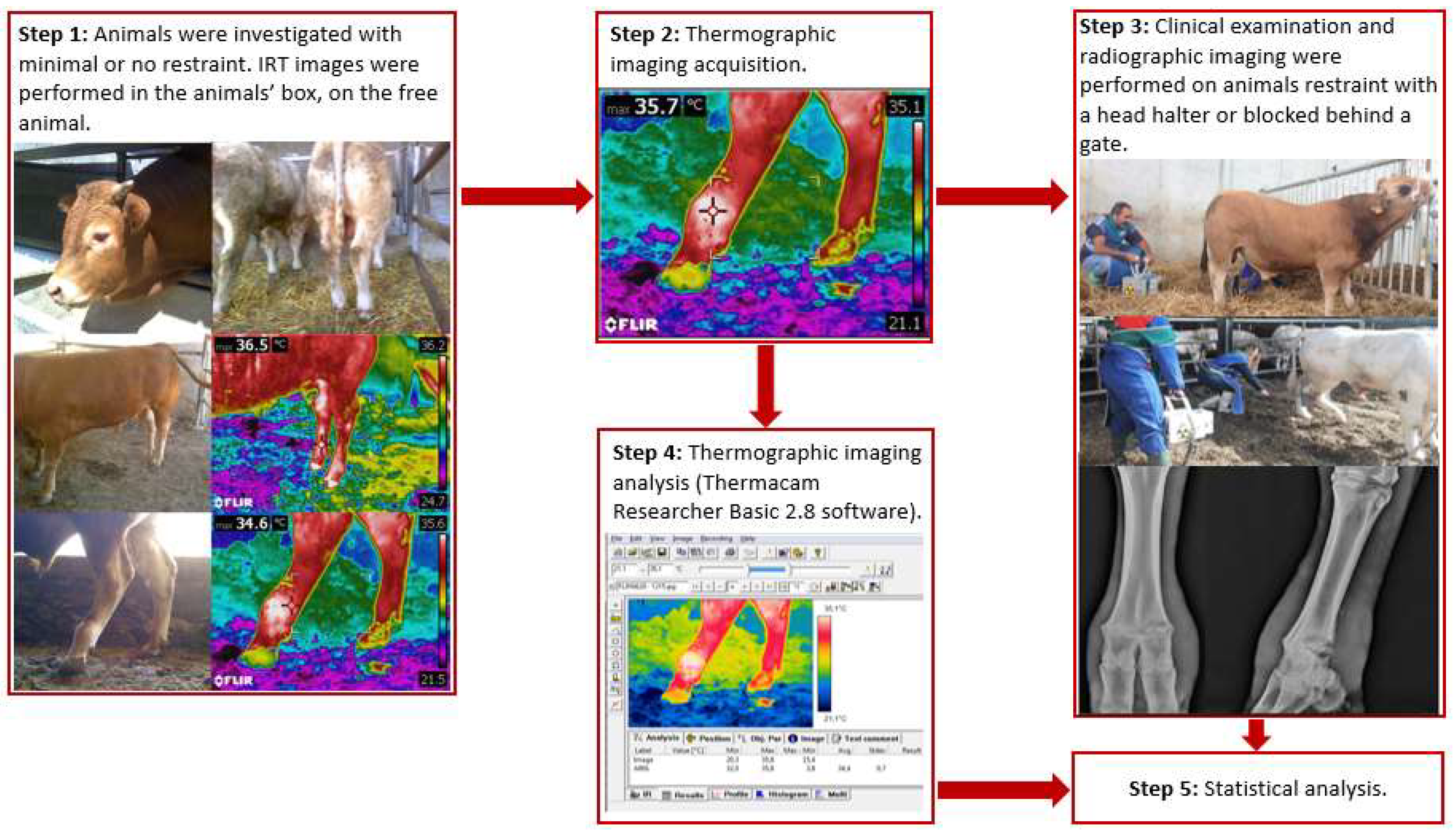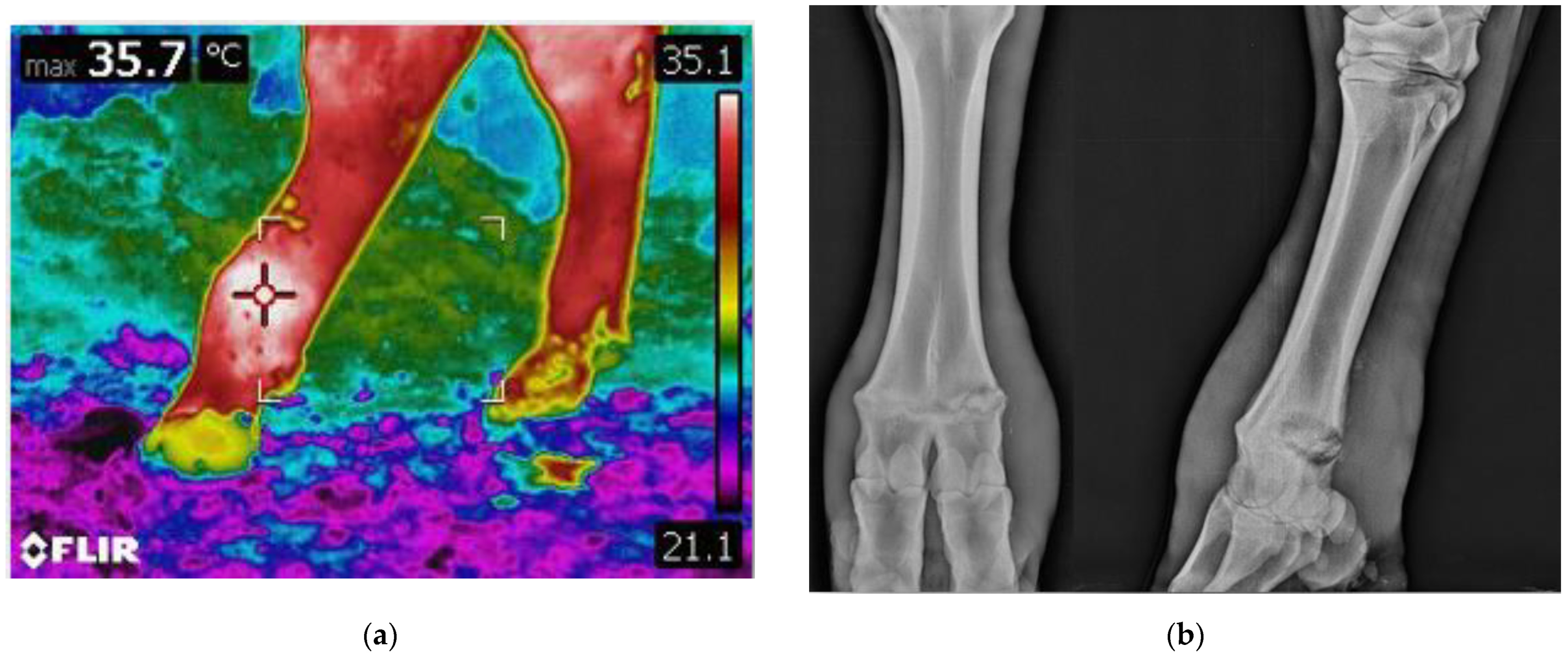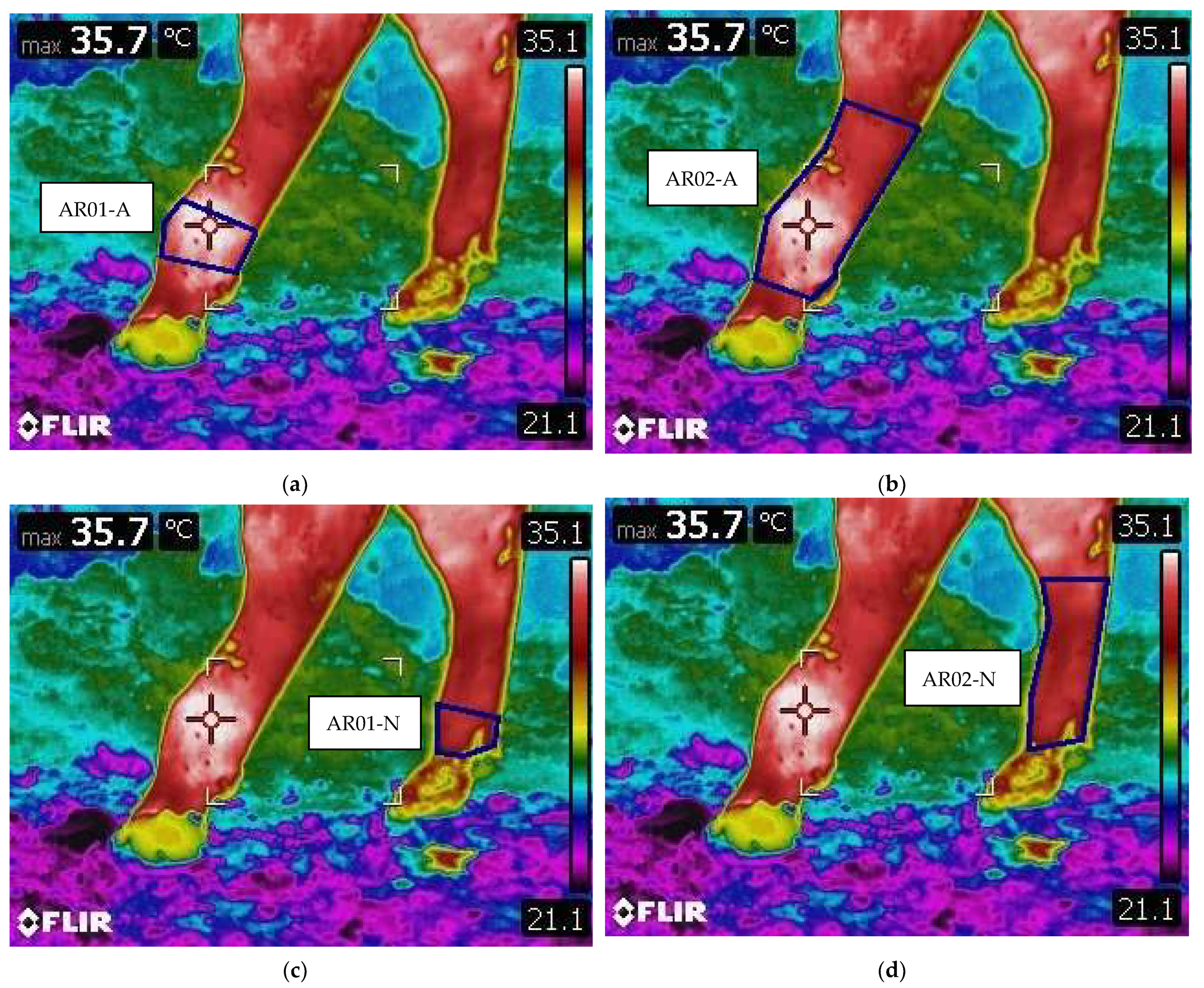Thermographic Screening of Beef Cattle Metatarsal Growth Plate Lesions
Abstract
:Simple Summary
Abstract
1. Introduction
2. Materials and Methods
2.1. Experimental Design
2.2. On Field Thermographic and Radiographic Imaging Acquisition, and Clinical Evaluations
2.3. Thermographic Imaging Analysis
2.4. Statistical Analysis
3. Results
4. Discussion
5. Conclusions
Author Contributions
Funding
Institutional Review Board Statement
Data Availability Statement
Acknowledgments
Conflicts of Interest
References
- Griffin, D.; Perino, L.; Hudson, D. Feedlot lameness. In Neb-Guide; University of Nebraska-Lincoln: Lincoln, NE, USA, 1993. [Google Scholar]
- Huxley, J.N. Impact of lameness and claw lesions in cows on health and production. Livest. Sci. 2013, 156, 64–70. [Google Scholar] [CrossRef]
- Fjeldaas, T.; Nafstad, O.; Fredriksen, B.; Ringdal, G.; Sogstad, A.M. Claw and limb disorders in 12 Norwegian beef-cow herds. Acta Vet. Scand. 2007, 49, 24–35. [Google Scholar] [CrossRef] [Green Version]
- Bicalho, R.C.; Machado, V.S.; Caixeta, L.S. Lameness in dairy cattle: A debilitating disease or a disease of debilitated cattle? A cross-sectional study of lameness prevalence and thickness of the digital cushion. J. Dairy Sci. 2009, 92, 3175–3184. [Google Scholar] [CrossRef] [Green Version]
- Levi, M.; Dittmer, K.E.; Gentile, A.; Beltrame, A.; Bolcato, M.; Morgante, M.; Fiore, E.; Benazzi, C. Growth plate lesions of fattening bulls. Vet. Pathol. 2017, 54, 437–444. [Google Scholar] [CrossRef] [PubMed]
- Bernath, C.; Nuss, K.; Dennler, M.; Counotte, M.; Geyer, H.; Devaux, D. Prevalence of metatarsal growth plate lesions in Swiss fattening bulls. Schweiz. Arch. Tierheilkd. 2021, 163, 709–720. [Google Scholar] [CrossRef]
- Steiner, S.; Gelfert, C.C.; Kofler, J. Herd problem ‘epiphysitis’ in fattening bulls—A case report [Bestandsproblem Epiphysitis bei Mastbullen—Fallbericht]. Klauentierpraxis 2009, 17, 48–55. [Google Scholar]
- Barneveld, A. Cancellous bone grafting in the treatment of bovine septic physitis. Vet. Q. 1994, 16, 104–107. [Google Scholar] [CrossRef] [Green Version]
- Fiore, E.; Levi, M.; Gianesella, M.; Benazzi, C.; Morgante, M.; Beltrame, A.; Vaccaro, C.; Gentile, A. Epiphysitis in fattening bulls: Radiological and pathologic findings. Large Anim. Rev. 2016, 22, 43–45. [Google Scholar]
- Houlihan, M.G.; Veenstra, B.; Christian, M.K.; Nicholas, R.; Ayling, R. Mastitis and arthritis in two dairy herds caused by Mycoplasma bovis. Vet. Rec. 2007, 160, 126–127. [Google Scholar] [CrossRef]
- Davies, I.H.; Munro, R. Osteochondrosis in bull beef cattle following lack of dietary mineral and vitamin supplementation. Vet. Rec. 1999, 145, 232–233. [Google Scholar] [CrossRef]
- Rizk, A.; El-Shafaey, E. Clinical and radiographic evaluation of distal cannon bone physitis in cattle. J. Anim. Vet. Adv. 2015, 14, 205–210. [Google Scholar]
- Fiore, E.; Perillo, L.; Marchesini, G.; Piccione, G.; Giudice, E.; Zumbo, A.; Armato, L.; Fabbri, G.; Gianesella, M. Effect of parity on claw horn lesions in Holstein dairy cows: Clinical and radiological study. Ann. Anim. Sci. 2019, 19, 147–158. [Google Scholar] [CrossRef] [Green Version]
- Verschooten, F.; Vermeiren, D.; Devriese, L. Bone infection in the bovine appendicular skeleton: A clinical, radiographic, and experimental study. Vet. Radiol. Ultrasound. 2000, 41, 250–260. [Google Scholar] [CrossRef] [PubMed]
- Enting, H.; Kooij, D.; Dijkhuizen, A.A.; Huirne, R.B.M.; Noordhuizen-Stassen, E.N. Economic losses due to clinical lameness in dairy cattle. Livest. Prod. Sci. 1997, 49, 259–267. [Google Scholar] [CrossRef]
- Dutra, F.; Carlsten, J.; Ekman, S. Hind limb skeletal lesions in 12-month-old bulls of beef breeds. J. Vet. Med. Ser. A 1999, 46, 489–508. [Google Scholar] [CrossRef] [PubMed]
- Trostle, S.S.; Nicoll, R.G.; Forrest, L.J.; Markel, M.D. Clinical and radiographic findings, treatment, and outcome in cattle with osteochondrosis: 29 cases (1986–1996). J. Am. Vet. Med. Assoc. 1997, 211, 1566–1570. [Google Scholar]
- Tryon, K.A.; Farrow, C.S. Osteochondrosis in cattle. Vet. Clin. N. Am. Food Anim. Pract. 1999, 15, 265–274. [Google Scholar] [CrossRef]
- Schaefer, A.L.; Cook, N.; Tessaro, S.V.; Deregt, D.; Desroches, G.; Dubeski, P.L.; Tong, A.; Godson, D.L. Early detection and prediction of infection using infrared thermography. Can. J. Anim. Sci. 2004, 84, 73–80. [Google Scholar] [CrossRef]
- McManus, C.; Tanure, C.B.; Peripolli, V.; Seixas, L.; Fischer, V.; Gabbi, A.M.; Menegassi, S.R.O.; Stumpf, M.T.; Kolling, G.J.; Dias, E.; et al. Infrared thermography in animal production: An overview. Comput. Electron. Agric. 2016, 123, 10–16. [Google Scholar] [CrossRef]
- Stokes, J.E.; Leach, K.A.; Main, D.C.; Whay, H.R. An investigation into the use of infrared thermography (IRT) as a rapid diagnostic tool for foot lesions in dairy cattle. Vet. J. 2012, 193, 674–678. [Google Scholar] [CrossRef] [PubMed]
- Turner, T.A.; Purohit, R.C.; Fessler, J.F. Thermography: A review in equine medicine. J. Equine Vet. Sci. 1986, 5, 8–10. [Google Scholar] [CrossRef]
- Phillips, P.K.; Heath, J.E. An infrared thermographic study of surface temperature in the euthermic woodchuckz (Marmota monax). Comp. Biochem. Physiol. 2001, 129, 557–562. [Google Scholar] [CrossRef]
- Fabbri, G.; Fiore, E.; Piccione, G.; Giudice, E.; Gianesella, M.; Morgante, M.; Armato, L.; Bonato, O.; Giambelluca, S.; Arfuso, F. Detection of digital and interdigital dermatitis in holstein friesian dairy cows by means of infrared thermography. Large Anim. Rev. 2020, 26, 113–116. [Google Scholar]
- Bowers, S.; Gandy, S.; Anderson, B.; Ryan, P.; Willard, S. Assessment of pregnancy in the late-gestation mare using digital infrared thermography. Theriogenology 2009, 72, 372–377. [Google Scholar] [CrossRef]
- Head, M.J.; Dyson, S. Talking the temperature of equine thermography. Vet. J. 2001, 162, 166–167. [Google Scholar] [CrossRef]
- Shearer, J.K.; Van Amstel, S.R.; Brodersen, B.W. Clinical diagnosis of foot and leg lameness in cattle. Vet. Clin. N. Am. Food Anim. Pract. 2012, 28, 535–556. [Google Scholar] [CrossRef]
- Sprecher, D.J.; Hostetler, D.E.; Kaneene, J.B. A lameness scoring system that uses posture and gait to predict dairy cattle reproductive performance. Theriogenology 1997, 47, 1179–1187. [Google Scholar] [CrossRef]
- Heath, A.M.; Carson, R.L.; Purohit, R.C.; Sartin, E.M.; Wenzel, J.G.W.; Wolfe, D.F. Effects of testicular biopsy in clinically normal bulls. J. Am. Vet. Med. Assoc. 2001, 220, 507–512. [Google Scholar] [CrossRef]
- Fita, K.; Dobrzyński, M.; Całkosiński, I.; Dudek, K.; Bader-Orłowska, D. The usefulness of the thermography in medical-dental diagnostic—The author’s experiences. Ann. Acad. Med. Stetin. 2007, 53, 34–38. [Google Scholar]
- Whay, H.R. Locomotion scoring and lameness detection in dairy cattle. Practice 2002, 24, 444–449. [Google Scholar] [CrossRef]
- Gianesella, M.; Arfuso, F.; Fiore, E.; Giambelluca, S.; Giudice, E.; Armato, L.; Piccione, G. Infrared thermography as a rapid and non-invasive diagnostic tool to detect inflammatory foot diseases in dairy cows. Polish J. Vet. Sci. 2018, 21, 299–305. [Google Scholar]
- Telezhenko, E.; Bergsten, C. Influence of floor type on the locomotion of dairy cows. Appl. Anim. Behav. Sci. 2005, 93, 183–197. [Google Scholar] [CrossRef]



| ROI | Parameters | Mean ± SD |
|---|---|---|
| AR01 | T°min (°C) | 24.43 ± 5.88 |
| T°max (°C) | 31.50 ± 3.78 | |
| ΔT°max − min (°C) | 7.08 ± 3.25 | |
| T°mean (°C) | 28.79 ± 4.53 | |
| AR02 | T°min (°C) | 21.46 ± 7.25 |
| T°max (°C) | 31.86 ± 3.77 | |
| ΔT°max − min (°C) | 10.40 ± 4.41 | |
| T°mean (°C) | 27.95 ± 5.30 |
| ROI | Parameters | Healthy Limb | Affected Limb | Difference between Affected and Healthy Measures (Least Sq Means (95% CI) |
|---|---|---|---|---|
| AR01 | T°min (°C) | 24.43 ± 5.88 | 25.31 ± 6.03 * | 1.8 (0.58–2.95) |
| T°max (°C) | 31.50 ± 3.78 | 32.51 ± 3.21 ** | 2.0 (1.11–2.93) | |
| ΔT°max − min (°C) | 7.08 ± 3.25 | 7.2 ± 3.39 | 0.3 (1.06–1.56) | |
| T°mean (°C) | 28.79 ± 4.53 | 29.72 ± 4.36 ** | 1.9 (1.11–2.64) | |
| AR02 | T°min (°C) | 21.46 ± 7.25 | 22.44 ± 7.08 | 1.9 (0.59–3.34) |
| T°max (°C) | 31.86 ± 3.77 | 32.62 ± 3.09 * | 1.5 (0.52–2.50) | |
| ΔT°max − min (°C) | 10.40 ± 4.41 | 10.17 ± 4.50 | −0.5 (−1.80–0.86) | |
| T°mean (°C) | 27.95 ± 5.30 | 28.82 ± 4.96 ** | 1.8 (0.98–2.52) |
Publisher’s Note: MDPI stays neutral with regard to jurisdictional claims in published maps and institutional affiliations. |
© 2022 by the authors. Licensee MDPI, Basel, Switzerland. This article is an open access article distributed under the terms and conditions of the Creative Commons Attribution (CC BY) license (https://creativecommons.org/licenses/by/4.0/).
Share and Cite
Fabbri, G.; Gianesella, M.; Tessari, R.; Bassini, A.; Morgante, M.; Contiero, B.; Faillace, V.; Fiore, E. Thermographic Screening of Beef Cattle Metatarsal Growth Plate Lesions. Animals 2022, 12, 191. https://doi.org/10.3390/ani12020191
Fabbri G, Gianesella M, Tessari R, Bassini A, Morgante M, Contiero B, Faillace V, Fiore E. Thermographic Screening of Beef Cattle Metatarsal Growth Plate Lesions. Animals. 2022; 12(2):191. https://doi.org/10.3390/ani12020191
Chicago/Turabian StyleFabbri, Giorgia, Matteo Gianesella, Rossella Tessari, Andrea Bassini, Massimo Morgante, Barbara Contiero, Vanessa Faillace, and Enrico Fiore. 2022. "Thermographic Screening of Beef Cattle Metatarsal Growth Plate Lesions" Animals 12, no. 2: 191. https://doi.org/10.3390/ani12020191
APA StyleFabbri, G., Gianesella, M., Tessari, R., Bassini, A., Morgante, M., Contiero, B., Faillace, V., & Fiore, E. (2022). Thermographic Screening of Beef Cattle Metatarsal Growth Plate Lesions. Animals, 12(2), 191. https://doi.org/10.3390/ani12020191







